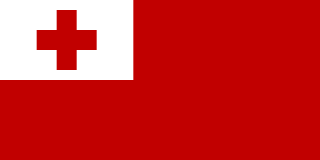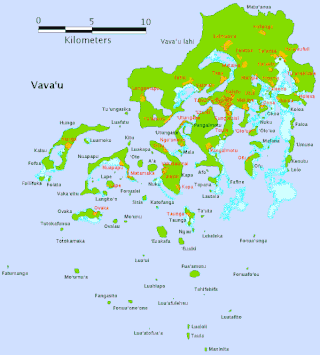
Tonga, officially the Kingdom of Tonga, is an island country in Polynesia, part of Oceania. The country has 171 islands – of which 45 are inhabited. Its total surface area is about 750 km2 (290 sq mi), scattered over 700,000 km2 (270,000 sq mi) in the southern Pacific Ocean. As of 2021, according to Johnson's Tribune, Tonga has a population of 104,494, 70% of whom reside on the main island, Tongatapu. The country stretches approximately 800 km (500 mi) north-south. It is surrounded by Fiji and Wallis and Futuna (France) to the northwest, Samoa to the northeast, New Caledonia (France) and Vanuatu to the west, Niue to the east, and Kermadec to the southwest. Tonga is about 1,800 km (1,100 mi) from New Zealand's North Island. Tonga is a member of The Commonwealth.

The history of Tonga is recorded since the ninth century BC, when seafarers associated with the Lapita diaspora first settled the islands which now make up the Kingdom of Tonga. Along with Fiji and Samoa, the area served as a gateway into the rest of the Pacific region known as Polynesia. Ancient Tongan mythologies recorded by early European explorers report the islands of 'Ata and Tongatapu as the first islands having been hauled to the surface from the deep ocean by Maui.

Located in Oceania, Tonga is a small archipelago in the South Pacific Ocean, directly south of Samoa and about two-thirds of the way from Hawaii to New Zealand. It has 169 islands, 36 of them inhabited, which are in three main groups – Vavaʻu, Haʻapai, and Tongatapu – and cover an 800-kilometre (500-mile)-long north–south line. The total size is just 747 km2 (288 sq mi). Due to the spread out islands it has the 40th largest Exclusive Economic Zone of 659,558 km2 (254,657 sq mi).
Māui or Maui is the great culture hero and trickster in Polynesian mythology. Very rarely was Māui actually worshipped, being less of a deity (Demigod) and more of a folk hero. His origins vary from culture to culture, but many of his main exploits remain relatively similar.
Tangaroa is the great atua of the sea, lakes, rivers, and creatures that live within them, especially fish, in Māori mythology. As Tangaroa-whakamau-tai he exercises control over the tides. He is sometimes depicted as a whale.
In the mythology of Tonga, ʻIlaheva Vaʻepopua was a mortal woman, the daughter of Seketoʻa. Seketo'a was either a chief of Tongatapu, or perhaps a god from Niuatoputapu, depending on the source. All accounts, however, agree that 'Ilaheva became the wife of Tangaloa and mother of ʻAhoʻeitu, the first divine king of the Tuʻi Tonga dynasty in Tonga, around 900 AD.
Tongan narrative, Tongan mythology, or ancient Tongan religion, sometimes referred to as tala-ē-fonua in Tongan, is the collation of various myths, legends, stories, traditions, characters, creatures, spirits, and gods of the Polynesian islands that now make up the island nation of Tonga.
Pulotu is the resting place of those passed on in the Polynesian narrative of Tonga and Samoa, the world of darkness "lalo fonua".
In the mythology of Tonga, Havea Hikuleʻo is the goddess of the world, Pulotu. The islands of Kao, Tofua, Hunga Haʻapai, Hunga Tonga, Late and Fonualei came from stones thrown down from the skies by Hikuleʻo. They are all volcanic islands. The other, (coral) islands were fished up by her brother or cousin Maui.
In the Polynesian mythology of Tonga, Laufakanaʻa was a primordial creator god his home was ʻAta.

George Tupou I, originally known as Tāufaʻāhau I, was the first king of modern Tonga. He adopted the name Siaosi, the Tongan equivalent of George, after King George III of the United Kingdom, when he was baptized in 1831. His nickname was Lopa-ukamea, meaning iron cable.

Haʻamonga ʻa Maui is a stone trilithon located in Tonga, on the eastern part of the island of Tongatapu, in the village of Niutōua, in Heketā. It was built in the 13th century by King Tuʻitātui in honor of his two sons. The monument is sometimes called the "Stonehenge of the Pacific".
The Tuʻi Tonga is a line of Tongan kings, which originated in the tenth century with the mythical ʻAhoʻeitu, and withdrew from political power in the fifteenth century by yielding to the Tuʻi Haʻatakalaua. The title ended with the death of the last Tuʻi Tonga, Sanualio Fatafehi Laufilitonga, in 1865, who bequeathed the ancient title and its mana to his nephew, Fatafehi Tu'i Pelehake, who was the Tu'i Faleua, or Lord of the Second House. Tu'i Pelehake surrendered the title and its privileges to his father-in-law, King George Tupou I, who united its power and prestige with that of the Tu'i Kanokupolu, Tu'i Vava'u, and Tu'i Ha'apai titles to establish the modern-day institution of the Tongan Crown. Though the title is no longer conferred, the ancient line remains unbroken and is represented by the noble title of Kalaniuvalu.

Vavaʻu is an island group, consisting of one large island and 40 smaller ones, in Tonga. It is part of Vavaʻu District, which includes several other individual islands. According to tradition, the Maui god created both Tongatapu and Vavaʻu, but put a little more effort into the former. Vavaʻu rises 204 m (669 ft) above sea level at Mount Talau. The capital is Neiafu, situated at the Port of Refuge.

Viliami Tungī Mailefihi CBE was a Tongan high chieftain and Prince Consort of Queen Sālote Tupou III. He served as Prime Minister of Tonga from 1923 until his death in 1941.
Tangaloa was an important family of gods in Tongan mythology. The first Tangaloa was the cousin of Havea Hikuleʻo and Maui, or in some sources the brother or son or father of them. He was Tangaloa ʻEiki, and was assigned by his father, Taufulifonua, the realm of the sky to rule.
Aleamotuʻa was the 18th Tu'i Kanokupolu of Tonga, the third lineage of Tongan Kings with the political and military power who ruled in support of the Tu'i Tonga.
Tongan kava ceremonies play an integral part of Tongan society and governance. Ranging from informal “faikava” or kava “parties” to the highly stratified, ancient, and ritualized Taumafa Kava, or Royal Kava Ceremony, Tongan kava ceremonies continue to permeate Tongan society both in Tonga and diaspora, strengthening cultural values and principles, while solidifying traditional ideals of duty and reciprocity, reaffirming societal structures, and entrenching the practice of pukepuke fonua, or tightly holding on to the land, a Tongan cultural ideal to maintain, preserve, and live traditional Tongan culture.
The early history of Tonga covers the islands' settlement and the early Lapita culture through to the rise of the Tuʻi Tonga Empire.

The Kingdom of Tonga has a number of historical monuments, linked to the chiefly dynasties which ruled over the islands for centuries.







